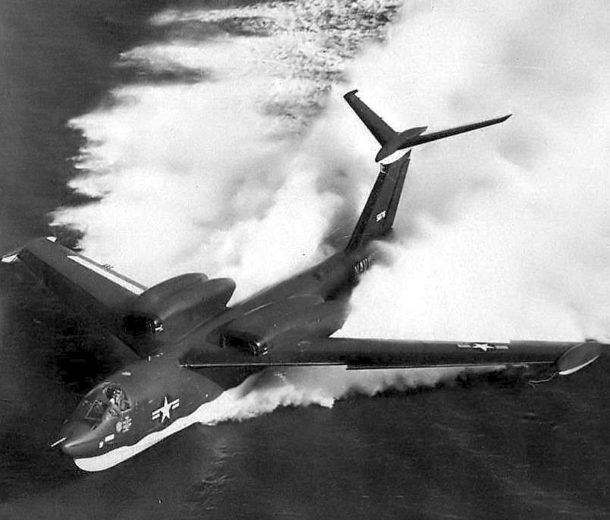
Fifty-eight years ago this month, the U.S. Navy’s first production Martin P6M-2 SeaMaster flyingboat took-off from Chesapeake Bay on its maiden flight. Martin chief test pilot George A. Rodney was at the controls of the 4-man, swept-wing naval bomber as it took to the skies on Tuesday, 17 February 1959.
Featuring a fuselage length of 134 feet, wingspan of 102 feet, and a wing leading edge sweep of 40 degrees, the P6M-2 had a GTOW of about 175,000 lbs. Armament included an ordnance load of 30,000 lbs and twin 20 mm, tail-mounted cannon. Power was provided by a quartet of Pratt and Whitney J75-P-2 turbojets; each delivering a maximum sea level thrust of 17,500 lbs.
The SeaMaster’s demonstrated top speed at sea level was in excess of Mach 0.90. This on-the-deck performance is comparable to that of the USAF/Rockwell B-1B Lancer and USAF/Northrup B-2 Spirit and exceeds that of the USAF/Boeing B-52 Stratofortress.
P6M pilots reported that the swept-wing ship handled well below 5,000 feet when flying at Mach numbers between 0.95 and 0.99. While designed for low altitude bombing and mine-laying, the aircraft was flown as high as 52,000 feet. As a result, the Navy even considered the SeaMaster as a nuclear weapons platform.
Despite the type’s impressive performance and capabilities, the SeaMaster Program was cancelled in August of 1959. Budgetary issues and the emerging Fleet Ballistic Missile System (Polaris-Poseidon-Trident) led to this decision. Loss of the P6M SeaMaster Program was devastating to the Glenn L. Martin Company and resulted in this notable aerospace business never again producing another aircraft.

